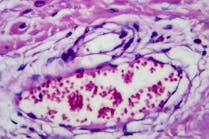Multiple studies have shown that African American women with breast cancer have lower survival rates than white women with the disease. But the association between race or ethnicity and treatment outcomes in triple-negative breast cancer — an aggressive type of tumor that does not respond to hormonal or other targeted therapies — has not been well defined.
Now, new research from Washington University School of Medicine in St. Louis shows that non-Hispanic African American women with triple-negative breast cancer also do not fare as well as non-Hispanic white women with this type of breast cancer. The study demonstrates the need for additional research to address disparities in cancer care and understand whether tumor biology or nonbiological reasons such as systemic racism — or a combination of such factors — may prevent African American women from receiving the same quality of care as white women.
The study appears online May 13 in JAMA Oncology.
Among women with triple-negative breast cancer, the researchers found that African Americans had a 28% increased risk of death compared with Americans of European descent, and that this disparity was at least partially due to lower rates of surgery and chemotherapy among African American patients.
About 10% to 12% of all invasive breast cancer diagnoses in the U.S. are triple-negative. And for reasons that remain unclear, African American women are at higher risk of developing triple-negative breast cancer than white American women.
For the study, researchers mined a large database maintained by the National Cancer Institute that included over 23,000 women diagnosed with triple-negative breast cancer from 2010 to 2015. Twenty-five percent of the patients were African American, and patients’ tumors were stages 1, 2 or 3, but not stage 4, meaning they had not yet spread to other parts of the body. In a follow-up 3½ years later, 3,276 patients had died from breast cancer. The five-year survival rate was about 77% for African American women and about 83% for white women.
Compared with white patients, African American patients had 31% lower odds of receiving surgery and 11% lower odds of receiving chemotherapy. Radiation therapy is used less often for this type of cancer, but the researchers found no difference between the two groups. After adjusting for socioeconomic factors, tumor stage and size, treatment differences and other factors, the risk of death among African Americans remained increased by 16%.
Even when chemotherapy was given, there was some evidence that the treatment was less effective in African American patients.
On average, African American patients were diagnosed at younger ages (56 years) than white patients (59 years). Tumors of African American patients also tended to be larger, diagnosed at more advanced stages and included more lymph node involvement, which is a sign the cancer is beginning to spread.
Additionally, African American patients were more likely to have health insurance through Medicaid and to live in urban areas and in counties that were more socioeconomically disadvantaged.
Curiously, researchers said the racial disparity in mortality was not found among triple-negative breast cancer patients over age 65 or those living in rural or socioeconomically poorer counties.





